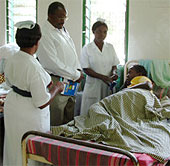Note: This article can also be found on the Maternal Health Task Force Blog.

Health care workers make rounds at a fistula ward in Uganda.
For women living with obstetric fistula who constantly leak urine or feces, the opportunity to undergo surgical repair can be life-changing. However, treatment itself can bring many challenges, including a long post-operative recuperation in the hospital. Long hospital stays present difficulties including physical discomfort, prolonged separation from spouse and family, the risk of hospital-acquired infections and opportunity costs such as loss of livelihood. A prime example of such an opportunity cost was described in an IRIN article that reported a fistula patient in Mali, Gounam Boukou Niafunke, lost her millet, gumbo and peanut crops during her long hospital stay for surgery and recovery. For hospitals with limited capacity, long post-operative stays also constrain how many women they can help and place pressure on overburdened staff.
One of the key factors that determines the length of post-operative inpatient stay is how long a woman needs bladder catheterization, a small tube inserted into the bladder through the urethra to drain urine, after surgery. Catheterization is an essential part of the healing process, but practices vary widely. An EngenderHealth Fistula Care Project (now the Fistula Care PlusProject) study found that bladder catheterization time (across all types of obstetric fistula) ranged from as little as five days to as long as 6 weeks. The average length of catheterization is two weeks, however there has been little to no evidence on what duration is best for promoting fistula healing.
To address this question, Fistula Care conducted a large multi-center randomized controlled trial to determine whether seven-day bladder catheterization can be used instead of 14-day catheterization. The results of this study have now been published in the Lancet: the findings demonstrate that short duration catheterization is safe and effective following simple fistula repair surgery. The trial randomized 524 participants needing simple fistula repair to seven-day versus 14-day catheterization at eight sites across eight African countries. It found no negative consequences when seven-day catheterization was used and no advantages to catheterizing women for longer periods of time. Most importantly, there was no statistically significant difference in the rate of repair breakdown in women who received seven-day and 14-day catheterization (4.0% vs. 3.2%, respectively). There were also no significant differences between the groups in secondary outcomes such as infections or fever.
Implementation of these findings has the potential to shorten hospital stays after fistula surgery, resulting in less discomfort and fewer side effects for women, lower costs to both women and the health system and treatment of more women at facilities with limited bed space.
Fistula Care selected this research topic after consulting with a wide range of partners to identify research areas with the greatest potential impact for women in fistula treatment programs. As noted by Dr. Ahmet Metin Gulmezoglu of the World Health Organization, “These findings can be easily put into practice, but will have the tremendous gain of allowing women to return to their daily lives more quickly and with less strain, as well as accommodating more surgical repairs.”
It’s crucial that research like this is translated into fistula treatment programs at the country level. The Fistula Care Plus Project is now working with partners to develop a clinical guideline to enable the surgeons, midwives and nurses who care for fistula patients to incorporate the study findings into new routines for fistula patients. In discussing the findings and their potential impact, Dr. Joseph Ruminjo, the Fistula Care Plus Clinical Director, has said, “These findings provide a major step forward in standardizing care and improving treatment for women. We hope that with continued research, along with enhanced prevention, access to treatment and reintegration efforts, we can, along with our partners, achieve the long-term goal to make fistula a rare event for future generations.”
This study was made possible through the U.S. Agency for International Development (USAID)-supported Fistula Care Plus project.
____
About obstetric fistula
Obstetric fistula is typically caused by obstructed labor lasting anywhere from two to nine days, after which the infant is most often stillborn and the woman is left with a hole in the birth canal leaving her incontinent, leaking urine and feces. While largely preventable, 1 to 2 million women are believed to be in current need of fistula repair. Women with obstetric fistula are sometimes abandoned or neglected by their husbands and families, often are unable to work and may be ostracized by their communities.
About Fistula Care Plus
Fistula Care Plus is a five-year fistula repair and prevention project managed by EngenderHealth and funded by the U.S. Agency for International Development. It builds on, enhances and expands the work undertaken by the previous Fistula Care project (2007–2013). With appropriate resources, awareness, knowledge and strong health systems for fistula prevention, treatment and reintegration, fistula can become a rare event for future generations. EngenderHealth’s partners in Fistula Care Plus are the Population Council, Dimagi, Direct Relief, Fistula Foundation, the Maternal Health Task Force and TERREWODE. Visit www.fistulacare.org for more information.
About EngenderHealth
EngenderHealth is a leading global women’s health organization committed to ensuring that every pregnancy is planned, every child is wanted and every mother has the best chance at survival. In 20 countries around the world, we train health care professionals and partner with governments and communities to make high-quality family planning and sexual and reproductive health services available today and for generations to come. Visitwww.engenderhealth.org for more information.


